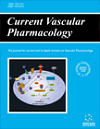-
oa Editorial [ Hot Topic: Current Topics on the Epidemiology, Pathogenesis, and Treatment of Diabetes Mellitus and its Complications (Guest Editors: Moses S. Elisaf and Evangelos C. Rizos)]
- Source: Current Vascular Pharmacology, Volume 10, Issue 2, Mar 2012, p. 138 - 139
-
- 01 Mar 2012
- Previous Article
- Table of Contents
- Next Article
Abstract
Diabetes mellitus is a leading health problem both in western societies as well as in developing countries. Diabetes affects more than 200 million people worldwide, with more than 3 million deaths attributed yearly to the disease, and World Health Organization (WHO) predictions expect a double increase of diabetes-related mortality until 2030 [1]. The diabetes-related burden of disease ranges from cardiovascular disease to stroke, kidney disease, visual loss and peripheral neuropathy (with diabetic foot ulcers) [2]. The economic impact of diabetes is enormous; WHO estimates that in the period 2006-2015, China will lose $558 billion in foregone national income due to heart disease, stroke and diabetes alone [1]. Taking into account the importance of diabetes, we invited distinguished authors in the field to give their perspective on current controversies in this supplemental issue of the Current Vascular Pharmacology journal. Heritability is one of the risk factors for both type 1 and type 2 diabetes. Type 2 diabetes mellitus (T2DM) is a complex disease modified by a number of environmental and genetic factors that contribute at varying degrees to the final phenotype and possibly interact with each other. Current approach in genetic epidemiology uses genome-wide association studies (GWAS) which serves to identify the gene targets that have been assessed to-date. It seems that only a minor fraction of the attributed diabetes heritability has been unravelled so far. Ntzani et al. review the current evidence on more than 60 identified loci implicated with T2DM. Despite the increasing numbers of identified genetic markers, a large proportion of the observed T2DM heritability remains unexplained [3, 4]. Larger GWAS on enhanced genotyping platforms, refined ascertainment of the characteristics for the populations under study and additional information from whole-genome sequencing will contribute to a more comprehensive view of the genetic background of the disease, with implications on new targets for drug development, as well as tailored pharmacogenetic approaches. Non-alcoholic fatty liver disease (NAFLD), with a prevalence of 70% among T2DM individuals, is characterized by hepatic steatosis in the absence of excessive alcohol consumption and ranges from steatosis to steatosis with necroinflammation and/or fibrosis (non-alcoholic steatohepatitis, NASH) to cirrhosis and even hepatocellular cancer [5, 6]. NAFLD and NASH are independently associated with higher mortality rates with cardiovascular disease (CVD) being the leading cause of death for these patients [7]. Tziomalos et al. review the current data on pharmacological agents which have been evaluated in NAFLD. Although most studies are small, short-term and yielded unsatisfactory results in terms of efficacy, it seems that vitamin E, metformin and pioglitazone are the most promising agents to date. Lifestyle modification with prevention of obesity is of paramount importance for the reduction of the prevalence of NAFLD in diabetic individuals. The goal for treating hypertension in patients with diabetes is the reduction of macrovascular and microvascular complications. Current guidelines recommend blood pressure (BP) levels < 130/80 mmHg [8]. Retrospective data analyses suggest an association between low BP levels with slower decline in chronic kidney disease (CKD) progression and greater cardiovascular risk reduction in T2DM patients. Kalaitzidis et al. suggest that such recommendations are not supported by appropriately powered prospective outcome trials [9]. Major limitations of most published trials of BP lowering in diabetes is the failure to either target or achieve mean systolic BP levels below 130mmHg. Data from recently published randomized trials do not support BP levels below 130/80 mmHg for all diabetic patients, whereas BP levels < 130/80mmHg are beneficial for stroke risk reduction in high risk patients, as well as for those patients with CKD (GFR <45 ml/min/1.73m2) who have > 500 mg albuminuria.


